Lactobacillus plantarum: Difference between revisions
No edit summary |
|||
| (60 intermediate revisions by one other user not shown) | |||
| Line 1: | Line 1: | ||
{{Uncurated}} | |||
==Classification== | ==Classification== | ||
[[Image:page4_1.gif|thumb|right|Image Citation: Bacterial Fermentation Pty Ltd, Dr John L. Reichelt, Director and Chief Microbiologist, bacferm.com. SEM image of ''Lacotbacillus plantarum''.http://www.bacferm.com.au/silac/micro/micro.html]] | [[Image:page4_1.gif|thumb|right|Image Citation: Bacterial Fermentation Pty Ltd, Dr John L. Reichelt, Director and Chief Microbiologist, bacferm.com. SEM image of ''Lacotbacillus plantarum''.http://www.bacferm.com.au/silac/micro/micro.html]] | ||
| Line 18: | Line 17: | ||
'''Genus''' : Lactobacillus | '''Genus''' : Lactobacillus | ||
'''Species''' : plantarum | '''Species''' : plantarum [http://www.ncbi.nlm.nih.gov/Taxonomy/Browser/wwwtax.cgi?mode=Info&id=1590&lvl=3&lin=f&keep=1&srchmode=1&unlock (10)] | ||
==Species== | |||
''Lactobacillus plantarum'' [http://www.ncbi.nlm.nih.gov/Taxonomy/Browser/wwwtax.cgi?mode=Info&id=1590&lvl=3&lin=f&keep=1&srchmode=1&unlock ( | ''Lactobacillus plantarum'' [http://www.ncbi.nlm.nih.gov/Taxonomy/Browser/wwwtax.cgi?mode=Info&id=1590&lvl=3&lin=f&keep=1&srchmode=1&unlock (10)] | ||
==Description and Significance== | ==Description and Significance== | ||
[[Image:picture101.gif|thumb|right|Phylogenetic Tree of Partial 16S rDNA Sequences. This tree shows the phylogenetic relationship of ''L. plantarum'' to a set of Lactic Acid Bacteria.[http://www.sciencedirect.com/science?_ob=ArticleURL&_udi=B6T7C-4J14P1Y-4&_user=1111158&_coverDate=09%2F30%2F2006&_rdoc=1&_fmt=high&_orig=search&_sort=d&_docanchor=&view=c&_searchStrId=1309861100&_rerunOrigin=google&_acct=C000051676&_version=1&_urlVersion=0&_userid=1111158&md5=a9d8a4574f033a9b588512a584088cc5 (5)]]] | |||
''L. plantarum'' is also | ''L. plantarum'' is a gram positive bacterium that is found in a variety of niches. These niches include dairy, meat, and much vegetable fermentations, it is also found in the human gastrointestinal tract. It is a facultative heterofermentative lactic acid bacterium that utilizes an extensive range of fermentatable carbon sources. Lactic acid bacteria are Gram-positive and they are non-spore forming, fermentative bacteria that grow anaerobically. The main function of these bacteria is the fermentative conversion of sugars present in raw materials into lactic acid. ''L. plantarum'' also produces anti-microbial peptides and exopolysaccharides. It has the ability to maintain a pH gradient between the inside and outside of the cell in the presence of large amounts of acetate or lactate. [http://www.sciencedirect.com/science?_ob=ArticleURL&_udi=B6T7C-4J14P1Y-4&_user=1111158&_coverDate=09%2F30%2F2006&_rdoc=1&_fmt=high&_orig=search&_sort=d&_docanchor=&view=c&_searchStrId=1309861100&_rerunOrigin=google&_acct=C000051676&_version=1&_urlVersion=0&_userid=1111158&md5=a9d8a4574f033a9b588512a584088cc5 (5)] ''L. plantarum'' is one of the most common microbes used as a silage inoculant. Silage is a fermented fodder that can be fed to ruminants or used as a biofuel feedstock for anaerobic digesters. [http://www.ncbi.nlm.nih.gov/pmc/articles/PMC201987/ (6) ] | ||
''L. plantarum'' is currently being explored to convert lignocellulosic biomass to biofuel and bioproducts. Current research into this idea is looking at a strain of ''L. plantarum'' which has certain genes inactivated to eliminate undesirable fermentation products. [http://www.ncbi.nlm.nih.gov/pubmed/18563659 (9)]''L. plantarum'' is also able to degrade cassava raw starch. Its ability to degrade raw starch is useful because it could potentially be used as a starter in certain traditional fermentation processes. [http://www.ncbi.nlm.nih.gov/pmc/articles/PMC201987/ (6) ] There are also potential uses for ''L. plantarum'' to be used in treatments of certain wastewater due to its ability to degrade phenolic compounds, such as those in olive mill wastewaters. [http://www.actahort.org/books/791/791_97.htm (2)] | |||
The ability of the this microbe to adapt and thrive in a range of environments, its ability and capacity to be genetically manipulated, as well as its ability to ferment and degrade different materials makes ''L. plantarum'' a very interesting and important bacteria to study. | |||
==Genome Structure== | |||
[[Image:genome.gif|thumb|right|Genome-atlas view of the ''L. plantarum'' chromosome.[http://www.pnas.org/content/100/4/1990.full (7)]]] | |||
''L. plantarum'' has one of the largest genomes among lactic acid bacteria. In its circular chromosome it contains 3,308,274 base pairs. The genome was sequenced by using whole genome sequencing as assembly approach. The overall GC content of its chromosome is 44.5%, the plasmids tend to have a lower percent GC content. | ''L. plantarum'' has one of the largest genomes among lactic acid bacteria. In its circular chromosome it contains 3,308,274 base pairs. The genome was sequenced by using whole genome sequencing as assembly approach. The overall GC content of its chromosome is 44.5%, the plasmids tend to have a lower percent GC content. | ||
Putative biological functions have been given to 2,120 of the predicted proteins. One particular interesting region of the chromosome is the 213-kb region from 3,072,500 – 3,28,500, which encodes proteins for sugar transport, metabolism, and regulation. This region has a lower percent CG content (41.5%), leading researchers to believe that many of these genes have been acquired by horizontal gene transfer. [http://www.pnas.org/content/100/4/1990.full ( | Putative biological functions have been given to 2,120 of the predicted proteins. One particular interesting region of the chromosome is the 213-kb region from 3,072,500 – 3,28,500, which encodes proteins for sugar transport, metabolism, and regulation. This region has a lower percent CG content (41.5%), leading researchers to believe that many of these genes have been acquired by horizontal gene transfer. [http://www.pnas.org/content/100/4/1990.full (7) ] | ||
''L. plantarum''has three plasmids, pWCFS101, pWCFS102, and pWCFS103. The plasmid sizes are as follows: pWCFS101 contains 1,917 bp, pWCFS102 contains 2,365 bp, and pWCFS103 contains 36,069 bp. Plasmid pWCFS101 is believed to contain replication proteins. Plasmid pWCFS102 is believed to contain replication proteins as well as proteins that function as copy number controls. Plasmid pWCFS103 contains genes that are predicted to be involved in arsenate and/or arsenite resistance as well as cadmium resistance; it also has genes that are believed to encode replication proteins, resolvases, DNA-damage-inducible proteins, and oxidases. ''L. plantarum'' contains two apparently complete prophage genomes, as well as some prophage remnants. [http://aem.highwire.org/cgi/content/abstract/71/3/1223 (8)] | |||
The ''L. plantarum'' chromosome reveals that this microbe has a major focus on carbon catabolism. The sequence of its chromosome also supports its extreme flexibility, versatility, and ability to adapt to different environmental conditions. [http://www.pnas.org/content/100/4/1990.full ( | The ''L. plantarum'' chromosome reveals that this microbe has a major focus on carbon catabolism. The sequence of its chromosome also supports its extreme flexibility, versatility, and ability to adapt to different environmental conditions. [http://www.pnas.org/content/100/4/1990.full (7) ] | ||
==Cell Structure, Metabolism and Life Cycle== | ==Cell Structure, Metabolism and Life Cycle== | ||
| Line 54: | Line 55: | ||
[[Image:metab1.png|thumb|Generalized schematic of the generation of metabolic | [[Image:metab1.png|thumb|Generalized schematic of the generation of metabolic | ||
energy and regulation of intracellular pH by decarboxylation and | energy and regulation of intracellular pH by decarboxylation and | ||
electrogenic antiport | electrogenic antiport.[http://www.springerlink.com/content/n38pj87507113608/ (3)] | ||
]] | ]] | ||
'' | ''L. plantarum'' has a rod shaped structure with rounded ends. This microbe is a gram positive bacteria meaning there is a high concentration of peptidoglycan in the cell wall, and lack an outercellular membrane. The organism is also Auxotrophic meaning that it synthesizes few organic compounds, when it has the ability to break down sugars and pyruvate. ''L. plantarum'' is also a facultative heterofermentative lactobacilli microorganism, this means that the organism takes carbon from sugars and pyruvate and the byproduct is either alcohol or lactic acid. This process happens in an aerotolerant environment meaning that oxygen is not present. When oxygen is present it is released as hydrogen peroxide which can be used as a weapon that kills off other bacteria. Do to the inability to handle oxygen the organism uses a manganese dependent process. This process uses metal as a pseudo catalase and lowers oxygen concentration which is favorable to the aerotolerant environment. Sugar is a key source of energy for the microorganism to degrade. [http://www.springerlink.com/content/n38pj87507113608/ (3)] | ||
During the degradation of sugar carbon is released and becomes a source of energy for the lactobacillus plantarum. When Lactobacillus plantarum is exhibiting a pyruvate metabolism it is similar to homolactic fermentation. This happens when growth occurs on glucose which is degraded to pyruvate though an EMP pathway. Once the pyruvate is formed it is converted to d and l-lactate though sterospecific lactate dehydrogenase enzymes [http://www.springerlink.com/content/n38pj87507113608/ (3)]. | |||
When | |||
==Ecology and Pathogenesis== | ==Ecology and Pathogenesis== | ||
[[Image:Lplantarum.jpg|thumb| | [[Image:Lplantarum.jpg|thumb|''Lactobacillus plantarum'' sold as a probiotic supplement. [http://www.customprobiotics.com/about_probiotics.htm (4) ] ]] | ||
'' | |||
''L. plantarum'' can be found in many different environments, most commonly it is isolated from plant material and the human gastrointestinal tract. [http://www.sciencedirect.com/science?_ob=ArticleURL&_udi=B6T7C-4J14P1Y-4&_user=1111158&_coverDate=09%2F30%2F2006&_rdoc=1&_fmt=high&_orig=search&_sort=d&_docanchor=&view=c&_searchStrId=1309861100&_rerunOrigin=google&_acct=C000051676&_version=1&_urlVersion=0&_userid=1111158&md5=a9d8a4574f033a9b588512a584088cc5 (5)] Researchers believe that the sequence of the ''L. plantarum'' genome has certain features that allow this microbe to be versatile and adaptive to different environments. [http://www.pnas.org/content/100/4/1990.full (7) ] It can grow in-between 15-45 °C and can grow at pH levels of 3.2 and greater. This versatility allows ''L. plantarum'' isolates to be found in human saliva, fermenting dairy products, plant material, silage, and even certain waste waters. It gains its energy through the fermentative conversion of sugars to lactic acid, as long as is able to go through this process, most environments will allow the growth of this microbe. Experts believe that the high number of regulatory genes causes this microorganism to be so adaptable. The most common habitat is in a protein enriched environment such as dairy because of its primary protein-degradation which produces peptides. A study showed that there are 144 N-terminals which can be used for peptidase cleavage. Another key part to describe the adaptability of this microorganism is its ability to perform horizontal gene transfer. This process is accomplished though natural competition, bacteriophage infection and more. Lactobacillus plantarum can perform these transformations because it can bind DNA and uptake that DNA. [http://www.pnas.org/content/100/4/1990.full (7)]. | |||
Recently ''L. plantarum'' has been identified as a probiotic. Probiotics are non-pathogenic microorganisms that can have a positive impact on human health when they are digested. They are becoming a very popular dietary supplement to many people, especially those who have gastrointestinal problems. [http://scialert.net/fulltext/?doi=pjbs.2008.613.617&org=11 (1) ] In this case, ''L. plantarum'' can be considered a human symbiont. When the probiotics are ingested regularly it is possible that the composition of microflora in the intestinal tract can be manipulated. This manipulation may allow an improvement of microbe balance, stabilization of digestive enzyme patterns, and immunomodulation by activating and regulating mucosa-associated and systemic immune system responses. The microflora found in the intestinal tract are thought to provide protection from pathogens. Some companies currently sell bottles containing ''L. plantarum'' as a probiotic to help with intestinal problems including IBS and IBD, stating that these bacteria help to "Balance the Intestinal Ecosystem." [http://www.customprobiotics.com/about_probiotics.htm (4) ] | |||
Along with its possible use as a probiotic, there is another very important use for ''L. plantarum.'' Gram positive bacteria have been researched for a long time for their possible ability to convert lignocellulosic biomass to biofuels and bioproducts. A current goal with this research is to genetically manipulate certain lactic acid bacteria to convert agricultural biomass into ethanol as well as other value-added products. ''L. plantarum'' is a widely studied species and has now become a model for genetic manipulations of lactic acid bacteria. Current studies are looking at the induction of different mutations into the chromosome to eliminate undesired products that come with fermentation. [http://www.ncbi.nlm.nih.gov/pubmed/18563659 (9)] | |||
==References== | ==References== | ||
(1) [http:// | (1) [http://scialert.net/fulltext/?doi=pjbs.2008.613.617&org=11 Adrian, V., Emanuel, V., Ovidiu, P., Gheorghe, C., Radu, A., et al. 2008. "Obtaining of a symbiotic product based on lactic bacteria, pollen and honey." '' Pak. J. Biol. Sci.'' Volume 11. p. 613-617.] | ||
( | (2) [http://www.actahort.org/books/791/791_97.htm Bronze, M., Vilas-Boas, L., Catulo, L., Peres, C. "Use of ''Lactobacillus platarum'' in Treatments of Olive Mill Wastewater" 2008. ''Acta Hort.'' Volume 791. p. 637-644.] | ||
( | (3) [http://www.springerlink.com/content/n38pj87507113608/ Christensen, J., Dudley, E., Pederson, J., Steele, J. "Peptidases and Amino Acid Catabolism in Lactic Acid Bacteria." ''Antonie Van Leeuwenhoek.'' 1999. Volume 76. p. 217-46. ] | ||
(4) [http://www.customprobiotics.com/about_probiotics.htm Custom Probiotics, Incorporated: About Probiotics. Accessed April 2010.] | |||
(5) [http://www.sciencedirect.com/science?_ob=ArticleURL&_udi=B6T7C-4J14P1Y-4&_user=1111158&_coverDate=09%2F30%2F2006&_rdoc=1&_fmt=high&_orig=search&_sort=d&_docanchor=&view=c&_searchStrId=1309861100&_rerunOrigin=google&_acct=C000051676&_version=1&_urlVersion=0&_userid=1111158&md5=a9d8a4574f033a9b588512a584088cc5 De Vries, M., Vaughan, E., Kleerebezem, M., De Vos, W. "Lactobacillus Plantarum—Survival, Functional and Potential Probiotic." ''International Dairy Journal.'' 2006. volume 16. p. 1018-028.] | |||
(6) [http://www.ncbi.nlm.nih.gov/pmc/articles/PMC201987/ Giraud, E., Champailler, A., Raimbult, R. "Degradation of Raw Starch by a Wild Amylolytic Strain of ''Lactobacillus platarum''." ''Appl Environ Microbiol.'' 1994. Volume 60. p. 4319-323.] | |||
(7) [http://www.pnas.org/content/100/4/1990.full Kleerebezem, M., Boekhoerst, J., Kranenburk, R., et al. “Complete Genome Sequence of ''Lactobacillus Plantarum'' WCFS1.” 2003. ''PNAS''. Volume 100.4. p. 1990-1995.] | |||
(8) [http://aem.highwire.org/cgi/content/abstract/71/3/1223 Kranenburg, R., Golic, N., Bongers, R., Leer, R., De Vos, W., Siezen, R., Kleerebezem, M. "Functional Analysis of Three Plasmids from Lactobacillus Plantarum." ''Applied and Environmental Microbiology.'' 2005. Volume 71.3. p. 1223-230. ] | |||
(9) [http://www.ncbi.nlm.nih.gov/pubmed/18563659 Liu, S. “A simple method to generate chromosomal mutations in Lactobacillus plantarum strain TF103 to eliminate undesired fermentation products.” 2006. ''Appl Biochem Biotechnol.'' Volume 131. p. 854-63.] | |||
(10) [http://www.ncbi.nlm.nih.gov/Taxonomy/Browser/wwwtax.cgi?mode=Info&id=1590&lvl=3&lin=f&keep=1&srchmode=1&unlock National Center for Biotechnology Information (NCBI). Taxonomy: Lactobacillus plantarum. Accessed March 2010.] | |||
==Author== | ==Author== | ||
Page authored by Stephanie LaHaye and Jason McIntyre, | Page authored by '''Stephanie LaHaye''' and '''Jason McIntyre''', students of [http://www.kbs.msu.edu/faculty/lennon/ Prof. Jay Lennon] at Michigan State University. | ||
<!-- Do not remove this line-->[[Category:Pages edited by students of Jay Lennon at Michigan State University]] | <!-- Do not remove this line-->[[Category:Pages edited by students of Jay Lennon at Michigan State University]] | ||
Latest revision as of 18:59, 25 August 2010
Classification
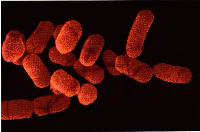
Domain : Bacteria
Phylum : Firmicutes
Class : Bacilli
Order : Lactobacillales
Family : Lactobacillaceae
Genus : Lactobacillus
Species : plantarum (10)
Species
Lactobacillus plantarum (10)
Description and Significance
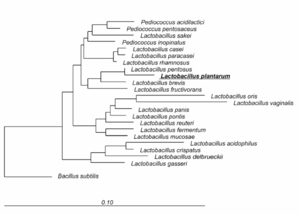
L. plantarum is a gram positive bacterium that is found in a variety of niches. These niches include dairy, meat, and much vegetable fermentations, it is also found in the human gastrointestinal tract. It is a facultative heterofermentative lactic acid bacterium that utilizes an extensive range of fermentatable carbon sources. Lactic acid bacteria are Gram-positive and they are non-spore forming, fermentative bacteria that grow anaerobically. The main function of these bacteria is the fermentative conversion of sugars present in raw materials into lactic acid. L. plantarum also produces anti-microbial peptides and exopolysaccharides. It has the ability to maintain a pH gradient between the inside and outside of the cell in the presence of large amounts of acetate or lactate. (5) L. plantarum is one of the most common microbes used as a silage inoculant. Silage is a fermented fodder that can be fed to ruminants or used as a biofuel feedstock for anaerobic digesters. (6)
L. plantarum is currently being explored to convert lignocellulosic biomass to biofuel and bioproducts. Current research into this idea is looking at a strain of L. plantarum which has certain genes inactivated to eliminate undesirable fermentation products. (9)L. plantarum is also able to degrade cassava raw starch. Its ability to degrade raw starch is useful because it could potentially be used as a starter in certain traditional fermentation processes. (6) There are also potential uses for L. plantarum to be used in treatments of certain wastewater due to its ability to degrade phenolic compounds, such as those in olive mill wastewaters. (2)
The ability of the this microbe to adapt and thrive in a range of environments, its ability and capacity to be genetically manipulated, as well as its ability to ferment and degrade different materials makes L. plantarum a very interesting and important bacteria to study.
Genome Structure
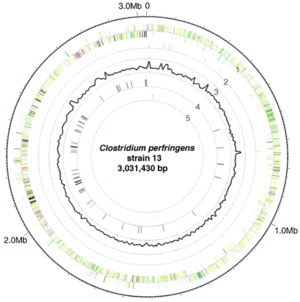
L. plantarum has one of the largest genomes among lactic acid bacteria. In its circular chromosome it contains 3,308,274 base pairs. The genome was sequenced by using whole genome sequencing as assembly approach. The overall GC content of its chromosome is 44.5%, the plasmids tend to have a lower percent GC content. Putative biological functions have been given to 2,120 of the predicted proteins. One particular interesting region of the chromosome is the 213-kb region from 3,072,500 – 3,28,500, which encodes proteins for sugar transport, metabolism, and regulation. This region has a lower percent CG content (41.5%), leading researchers to believe that many of these genes have been acquired by horizontal gene transfer. (7)
L. plantarumhas three plasmids, pWCFS101, pWCFS102, and pWCFS103. The plasmid sizes are as follows: pWCFS101 contains 1,917 bp, pWCFS102 contains 2,365 bp, and pWCFS103 contains 36,069 bp. Plasmid pWCFS101 is believed to contain replication proteins. Plasmid pWCFS102 is believed to contain replication proteins as well as proteins that function as copy number controls. Plasmid pWCFS103 contains genes that are predicted to be involved in arsenate and/or arsenite resistance as well as cadmium resistance; it also has genes that are believed to encode replication proteins, resolvases, DNA-damage-inducible proteins, and oxidases. L. plantarum contains two apparently complete prophage genomes, as well as some prophage remnants. (8)
The L. plantarum chromosome reveals that this microbe has a major focus on carbon catabolism. The sequence of its chromosome also supports its extreme flexibility, versatility, and ability to adapt to different environmental conditions. (7)
Cell Structure, Metabolism and Life Cycle
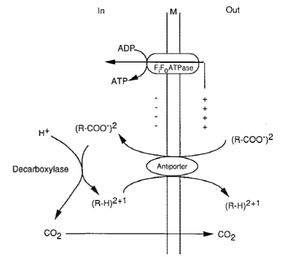
L. plantarum has a rod shaped structure with rounded ends. This microbe is a gram positive bacteria meaning there is a high concentration of peptidoglycan in the cell wall, and lack an outercellular membrane. The organism is also Auxotrophic meaning that it synthesizes few organic compounds, when it has the ability to break down sugars and pyruvate. L. plantarum is also a facultative heterofermentative lactobacilli microorganism, this means that the organism takes carbon from sugars and pyruvate and the byproduct is either alcohol or lactic acid. This process happens in an aerotolerant environment meaning that oxygen is not present. When oxygen is present it is released as hydrogen peroxide which can be used as a weapon that kills off other bacteria. Do to the inability to handle oxygen the organism uses a manganese dependent process. This process uses metal as a pseudo catalase and lowers oxygen concentration which is favorable to the aerotolerant environment. Sugar is a key source of energy for the microorganism to degrade. (3)
During the degradation of sugar carbon is released and becomes a source of energy for the lactobacillus plantarum. When Lactobacillus plantarum is exhibiting a pyruvate metabolism it is similar to homolactic fermentation. This happens when growth occurs on glucose which is degraded to pyruvate though an EMP pathway. Once the pyruvate is formed it is converted to d and l-lactate though sterospecific lactate dehydrogenase enzymes (3).
Ecology and Pathogenesis
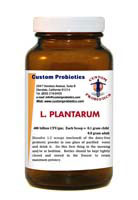
L. plantarum can be found in many different environments, most commonly it is isolated from plant material and the human gastrointestinal tract. (5) Researchers believe that the sequence of the L. plantarum genome has certain features that allow this microbe to be versatile and adaptive to different environments. (7) It can grow in-between 15-45 °C and can grow at pH levels of 3.2 and greater. This versatility allows L. plantarum isolates to be found in human saliva, fermenting dairy products, plant material, silage, and even certain waste waters. It gains its energy through the fermentative conversion of sugars to lactic acid, as long as is able to go through this process, most environments will allow the growth of this microbe. Experts believe that the high number of regulatory genes causes this microorganism to be so adaptable. The most common habitat is in a protein enriched environment such as dairy because of its primary protein-degradation which produces peptides. A study showed that there are 144 N-terminals which can be used for peptidase cleavage. Another key part to describe the adaptability of this microorganism is its ability to perform horizontal gene transfer. This process is accomplished though natural competition, bacteriophage infection and more. Lactobacillus plantarum can perform these transformations because it can bind DNA and uptake that DNA. (7).
Recently L. plantarum has been identified as a probiotic. Probiotics are non-pathogenic microorganisms that can have a positive impact on human health when they are digested. They are becoming a very popular dietary supplement to many people, especially those who have gastrointestinal problems. (1) In this case, L. plantarum can be considered a human symbiont. When the probiotics are ingested regularly it is possible that the composition of microflora in the intestinal tract can be manipulated. This manipulation may allow an improvement of microbe balance, stabilization of digestive enzyme patterns, and immunomodulation by activating and regulating mucosa-associated and systemic immune system responses. The microflora found in the intestinal tract are thought to provide protection from pathogens. Some companies currently sell bottles containing L. plantarum as a probiotic to help with intestinal problems including IBS and IBD, stating that these bacteria help to "Balance the Intestinal Ecosystem." (4)
Along with its possible use as a probiotic, there is another very important use for L. plantarum. Gram positive bacteria have been researched for a long time for their possible ability to convert lignocellulosic biomass to biofuels and bioproducts. A current goal with this research is to genetically manipulate certain lactic acid bacteria to convert agricultural biomass into ethanol as well as other value-added products. L. plantarum is a widely studied species and has now become a model for genetic manipulations of lactic acid bacteria. Current studies are looking at the induction of different mutations into the chromosome to eliminate undesired products that come with fermentation. (9)
References
(4) Custom Probiotics, Incorporated: About Probiotics. Accessed April 2010.
Author
Page authored by Stephanie LaHaye and Jason McIntyre, students of Prof. Jay Lennon at Michigan State University.
